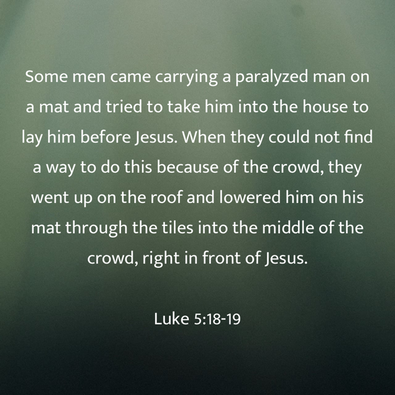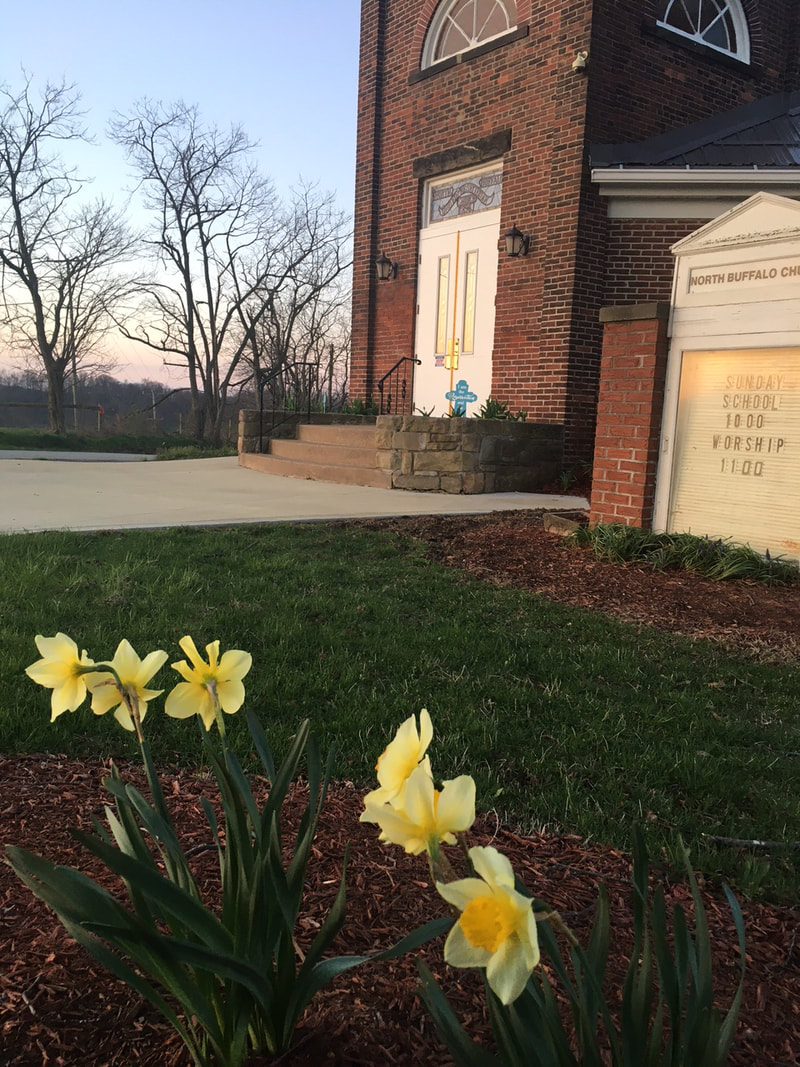|
Good morning!
We're so glad you decided to join us today!
Each week when we meet together, we take some time to share any joys and concerns we have from the past week. If you have a prayer request, please add it as a comment to this post. When you are ready, use the prayer below (source) to get started.
Lord, thank you for your unconditional love. May you lead us in the right path and enlighten our mind with the truth. May we see the needs of others, love, and serve one another. Give us strength to inspire others. Heal all the people through your love. We have faith in you and we will be with you, forever. This we pray, in the Mighty Name of Jesus Christ. Amen.
This week's lesson is on Luke 5:17-26.
Lesson Context
This gospel and the book of Acts were written by a man named Luke. He was a traveling companion of Paul and a physician (Colossians 4:14; 2 Timothy 4:11; Philemon 24). He gathered his information from people who had witnessed the ministry of Jesus so he could write a detailed account. Most biblical scholars believe that the gospel of Mark was written first, and could have been one of Luke's sources. Today's lesson puts Jesus in Galilee early in his three and a half year ministry. In Luke's telling, the miracle just prior to this one occurred, "in one of the towns," of Galilee. Mark's version specifically places this in Capernaum. This town, located on the northwestern bank of the Sea of Galilee, became something of a headquarters for Jesus during his tours of Galilee.
Faith that Seeks (verses 17-20a)
This passage is the first time that Luke mentions the Pharisees in his gospel. Our book also says that, while many places in the gospels have the translation, "teachers of the law," the original Greek word here only occurs in two other places (Acts 5:34; 1 Timothy 1:7). These teachers are experts in the Mosaic law, able to give sound theological opinions. The presence of these men in the crowd is ominous. They are not religious leaders from Galilee. These men have traveled from Judea and Jerusalem, about an 80 mile walk. The commitment for this trip meant that the work of Jesus required a thorough investigation. Isaiah 61:1-2 is a messianic prophecy, which Jesus read shortly before our passage:
The Spirit of the Sovereign Lord is on me,
because the Lord has anointed me to proclaim good news to the poor. He has sent me to bind up the brokenhearted, to proclaim freedom for the captives and release from darkness for the prisoners, to proclaim the year of the Lord’s favor and the day of vengeance of our God, to comfort all who mourn,
Luke links the healings, both physical and spiritual, as fulfillment of messianic prophecy.
The passage then shifts to the familiar story. Some men carry their paralyzed friend, in the hope that Jesus will heal him. This is a great example of the second greatest commandment: love your neighbor as yourself (Matthew 22:39; Mark 12:31). The man's affliction made it impossible for him to come to Jesus without assistance. But the crowd was so great, the man could not be taken directly to Jesus. First-century Palestinian houses typically had flat roofs with exterior steps or a ladder providing access. Roofs were built with beams resting on the outer walls, with smaller posts crossing the beams and covered with thatch and mud. The rooftop was a place for household activities, drying laundry, and getting fresh air. It was also where people sometimes hid, conferred, mourned and prayed. The paralyzed man's friends were able to carry him up to the roof, and then lower him down. Faith is a mental and spiritual state. We can see evidence of someone's faith in their actions. The crowd definitely saw evidence in the actions of the men. But Jesus could see their faith.
Faith that Finds (verses 20b-26)
Jesus addresses the paralyzed man. The gospel of Luke uses a generic Greek word for friend, while Matthew and Mark use a Greek word that can be translated as, "son." Jesus tells the man his sins are forgiven. The Pharisees and teachers of the law see this statement as blasphemy. God alone can forgive sins. This is correct, in the sense of a person sinning against God. According to Jewish writings in the period between the Old and New Testaments, the Jews expected a righteous Messiah to overthrow foreign invaders. They did not expect a Messiah who would be God-in-the-flesh, able to forgive sins. Our book says that the experts actually had a good grasp of what was happening. Jesus was speaking and acting in a manner reserved for God. For a mere human to forgive sins committed against God would indeed be blasphemy. This is the first instance of organized opposition to Jesus in the Gospel of Luke. Just like Jesus could see the faith of the paralyzed man, he knew what the Pharisees were thinking about. The ability to know people's hearts and innermost thoughts is one of the divine characteristics of Jesus that Luke emphasizes. Jesus asks the Pharisees and teachers of the law about their thoughts. He then follows up with another question. Our book explains that this could be taken as a couple of different kinds of arguments. Then Jesus tells the man to get up, take his mat and go home. The text here, in Matthew 9:6 and Mark 2:10-11, stress that Jesus healed the paralyzed man as evidence of Jesus' authority on Earth to forgive sin. This passage is also the first time that Luke records Jesus calling himself, "Son of Man." Through the four gospels, this phrase occurs more than 80 times. This designation comes from the Old Testament. In Ezekiel, the title is applied to the prophet, through without suggesting divinity. In the book of Daniel, the designation recognizes the Son of Man as having divine attributes. The paralyzed man is immediately healed. As soon as Jesus has spoken, the man is instantly healed. The man's sudden ability to walk should have been evidence that Christ had both the right and ability to forgive sins. Everyone saw the result. In biblical times, two or three witnesses were required to prove an event was true. Luke confirms that a sufficient number of witnesses were present to verify the miracle. Verse 26 is the only verse in the New Testament where amazement, praising God, and fear occur together as the reactions of a crowd. It is not unreasonable to think that the religious leaders were included in the people having these reactions. The reaction at the end of this passage is one of confused neutrality. The crowd hasn't yet reached a conclusion.
Conclusion
The friends in today's lesson remind us of the nature of authentic friendship. We do not know how long they had been carrying their friend around on this bed. We know that when Jesus came into the city, they believed he could help their friend. However, they did not stop at simply believing. They put their faith into action and brought their friend to Jesus, overcoming every obstacle on the way.
Prayer
Father, we are grateful for the friends who have helped us on our faith journey. We pray that you will help us be the friend who carries the bed of another when needed, regardless of the obstacles in our path. We give you thanks for friends and the strength to be a friend in Jesus' name. Amen.
Questions for Discussion
Benediction
This week's benediction comes from the King James Version.
Next week's lesson will be on Luke 7:1-10.
0 Comments
Leave a Reply. |
AuthorWe are a small, rural Presbyterian church in southwestern Pennsylvania. Archives
July 2024
Categories
All
|



 RSS Feed
RSS Feed